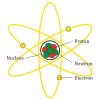The Kharan Desert (Urdu: خاران صحرا; also known as Sandy Desert) is a sandy-mountainous desert located in north-west Balochistan Province of Pakistan.[1] The Kharan District is located in the desert and the only inhabitant area to be found in the desert region.[1] Kharan desert is Pakistan's second nuclear test site, and the second nuclear test — Codename Chagai-II— was conducted and supervised by the Pakistan Atomic Energy Commission (PAEC) in May 30, 1998.[1]{ Most of its territory was in the Sandy Desert, but included also parts of the Central Makran Range.[1]
Topography
The desert is characterized by extremes of altitude and extreme temperatures in the desert.[1] The Kharan Desert consists of shifting sand dunes with an underlying pebble-conglomerate floor.[1] The moving dunes reach heights of between 15 and 30 meters.[1] Level areas between the dunes are a hard-topped pan when dry and a treacherous, sandy-clay mush when wet.[1] The altitudes of deserts slope from about 1,000m in the north to about 250m on in the south-west.[1] Average annual rainfall throughout these deserts is well under 100 mm.[1] The desert includes areas of inland drainage and dry lakes (hamuns).[1] The area is known particularly for its constant mirages and sudden severe sandstorms.[1]
Nuclear Site
Pakistan Army's Brigadier-General Muhammad Sarfraz, who had provided support to the Pakistan Atomic Energy Commission (PAEC) survey team, was tasked by President-General Muhammad Zia ul-Haq in 1977 with creating and leading the special military unit, called Special Development Works (SDW) which was entrusted with the task of preparing the nuclear test sites.[2] Meetings between SDW and PAEC officials and General Zia-ul-Haq led to the decision to prepare a second site for a horizontal shaft.[2] The site selected was located at Kharan, in a desert valley between the Ras Koh Hills to the north and Siahan Range to the south.[2] Subsequently, the Chagai Hills-Ras Koh-Kharan areas became restricted entry zones and were closed to the public.[2]
The construction of Kharan Desert nuclear test site took 2–3 years to prepare and were completed in 1980, before Pakistan acquired the capability to develop a nuclear weapon.[2] After the Brigadier General Sarfaraz, the task was assigned to lieutenant-general Zahid Ali Akbar Khan of Pakistan Army Corps of Engineers (PACE), who was the head of then-Military Engineering Service, Corps of Engineers as well as Special Works Development (SDW).[3] The task was undertaken by the Corps of Engineer's special military unit, Frontier Works Organization (FWO), famous for its construction of Karakorum Highways.[4][4] The FWO has uncredited work with PAEC's Chagai-II nuclear test site, and had supervised the complete construction on the sites along with SDW.[4] The construction was supervised by the Pakistan Army Corps of Engineers's combat engineer then-Lieutenant-Colonel Zulfikar Ali Khan and the Pakistan Atomic Energy Commission under the leadership of Chairman Mr. Munir Ahmad Khan who co-assigned this task to Member (Technical), PAEC, Ishfaq Ahmad.[4][3]
Chagai-II
A second nuclear test was conducted and performed in the Kharan Desert on May 30th of 1998 under codename — Chagai-II — at 13:10 p.m. (PST).[5] The nuclear test device was a miniaturized boosted plutonium device yielding 60% of the Ras Koh Hills tests.[5] The yield of a nuclear device was reported to be 18-20 kt of TNT equivalent.[5] A crater now takes the place of what used to be a small hillock in the rolling desert, marking the ground zero of the nuclear test there.[5] The Pakistan Atomic Energy Commission (or PAEC) had tested one or more plutonium nuclear devices, and the results and data of the devices were successful as it was expected by the Pakistan's mathematicians and seismologists.[6] The devices were successfully tested and supervised by PAEC's Chief Technical Member (CTM) dr. Samar Mubarakmand.[5]
Legacy
May 30th has been officially declared as Youm-e-Takbeer (Day of Greatness) and as well as National Science Day in Pakistan to commemorate and remembrance of the first five tests that were carried out in May 28, 1998.[7] The day was officially signed by the then-Prime Minister of Pakistan Navaz Scharief. The day is celebrated by giving awards (such as Chagai-Medal) to various individuals and industries in the field of science and industries.[8] The Navaz Scharief Government also established the Chagai-I Medal and it was first awarded to the scientists of Pakistan in 1998 who were witnessed the tests.[9] The graphite mountains are visibly shown in the gold medallion and equal ribbon stripes of yellow, red and white.[9]

